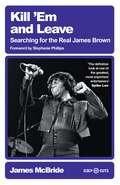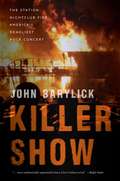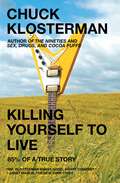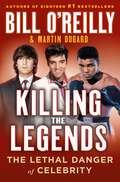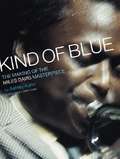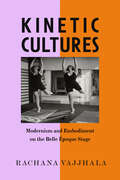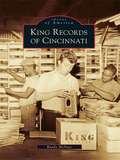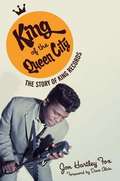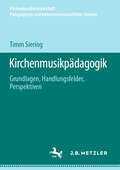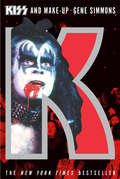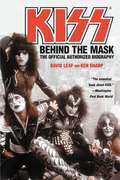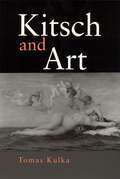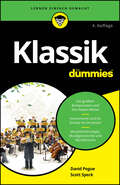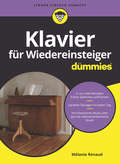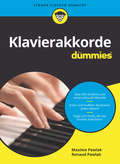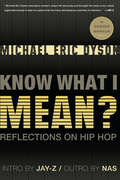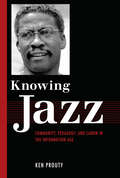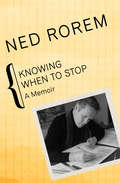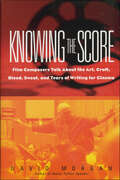- Table View
- List View
Kill 'Em and Leave: Searching for the Real James Brown
by James McBride'A formidable free-style book that isn't straight biography but a mix of history, street-level investigative reporting, hagiography, Deep South sociology, music criticism, memoir and some fiery preaching' Rolling Stone magazineA Guardian best music book of 2016The music of James Brown was almost a genre in its own right, and he was one of the biggest and most influential cultural figures of the twentieth century. But the singer known as the 'Hardest Working Man in Show Business' was also an immensely troubled, misunderstood and complicated man. Award-winning writer James McBride, himself a professional musician, has undertaken a journey of discovery in search of the 'real' James Brown, delving into the heartbreaking saga of Brown's childhood and destroyed estate, and uncovering the hidden history of Brown's early years.
Killer Show: The Station Nightclub Fire, America's Deadliest Rock Concert
by John BarylickOn February 20, 2003, the deadliest rock concert in U.S. history took place at a roadhouse called The Station in West Warwick, Rhode Island. That night, in the few minutes it takes to play a hard-rock standard, the fate of many of the unsuspecting nightclub patrons was determined with awful certainty. The blaze was ignited when pyrotechnics set off by Great White, a 1980s heavy-metal band, lit flammable polyurethane “egg crate” foam sound insulation on the club’s walls. In less than 10 minutes, 96 people were dead and 200 more were injured, many catastrophically. The final death toll topped out, three months later, at the eerily unlikely round number of 100. The story of the fire, its causes, and its legal and human aftermath is one of lives put at risk by petty economic decisions―by a band, club owners, promoters, building inspectors, and product manufacturers. Any one of those decisions, made differently, might have averted the tragedy. Together, however, they reached a fatal critical mass. Killer Show is the first comprehensive exploration of the chain of events leading up to the fire, the conflagration itself, and the painstaking search for evidence to hold the guilty to account and obtain justice for the victims. Anyone who has entered an entertainment venue and wondered, “Could I get out of here in a hurry?” will identify with concertgoers at The Station. Fans of disaster nonfiction and forensic thrillers will find ample elements of both genres in Killer Show.
Killing Yourself to Live: 85% of a True Story
by Chuck KlostermanBuilding on the national bestselling success of Sex, Drugs, and Cocoa Puffs, preeminent pop culture writer Chuck Klosterman unleashes his best book yet--the story of his cross-country tour of sites where rock stars have died and his search for love, excitement, and the meaning of death.For 6,557 miles, Chuck Klosterman thought about dying. He drove a rental car from New York to Rhode Island to Georgia to Mississippi to Iowa to Minneapolis to Fargo to Seattle, and he chased death and rock 'n' roll all the way. Within the span of twenty-one days, Chuck had three relationships end--one by choice, one by chance, and one by exhaustion. He snorted cocaine in a graveyard. He walked a half-mile through a bean field. A man in Dickinson, North Dakota, explained to him why we have fewer windmills than we used to. He listened to the KISS solo albums and the Rod Stewart box set. At one point, poisonous snakes became involved. The road is hard. From the Chelsea Hotel to the swampland where Lynyrd Skynyrd's plane went down to the site where Kurt Cobain blew his head off, Chuck explored every brand of rock star demise. He wanted to know why the greatest career move any musician can make is to stop breathing...and what this means for the rest of us.
Killing the Legends: The Lethal Danger of Celebrity (Killing series #12)
by Bill O'Reilly Martin DugardIn the next book in the multimillion-selling Killing Series, Bill O'Reilly and Martin Dugard tell the larger-than-life stories of Elvis Presley, John Lennon, and Muhammad Ali.The King is dead. The Walrus is shot. The Greatest is no more.Elvis Presley, John Lennon, and Muhammad Ali. These three icons changed not only the worlds of music, film, and sports, but the world itself. Their faces were known everywhere, in every nation, across every culture. And their stories became larger than life—until their lives spun out of control at the hands of those they most trusted.In Killing the Legends, Bill O’Reilly and Martin Dugard explore the lives, legacies, and tragic deaths of three of the most famous people of the 20th century. Each experienced immense success, then failures that forced them to change; each faced the challenge of growing old in fields that privilege youth; and finally, each became isolated, cocooned by wealth but vulnerable to the demands of those in their innermost circles. Dramatic, insightful, and immensely entertaining, Killing the Legends is the twelfth book in O’Reilly and Dugard’s Killing series: the most popular series of narrative history books in the world, with more than 18 million copies in print.
Kimberly Akimbo
by David Lindsay-Abaire and Jeanine TesoriNEW JERSEY, 1999. Kimberly is about to turn sixteen and has recently moved with her family to a new town in suburban New Jersey. Suffering from a disease that causes her to age four and a half times faster than her high school peers, surrounded by a dysfunctional family (and possible felony charges), Kimberly is also navigating her first teenage crush. Ever the optimist, Kimberly is determined to find happiness against all odds and embark on a great adventure.
Kind of Blue: The Making of the Miles Davis Masterpiece
by Ashley Kahn Jimmy CobbAn account of the creation, recording, and selling of Kind of Blue, a jazz classic. Many photos are described and have captions.
Kindergarten Kids: Riddles, Rebuses, Wiggles, Giggles, And More! (Into Reading, Read Aloud #Module 1, Book 3)
by Stephanie Calmenson Melissa SweetNIMAC-sourced textbook
Kinetic Cultures: Modernism and Embodiment on the Belle Epoque Stage (California Studies in 20th-Century Music #32)
by Rachana VajjhalaBelle époque Paris adored dance. Whether at the music hall or in more refined theaters, audiences flocked to see the spectacles offered to them by the likes of Isadora Duncan, Diaghilev’s flashy company, and an embarrassment of Salomés. After languishing in the shadow of opera for much of the nineteenth century, ballet found itself part of this lively kinetic constellation. In Kinetic Cultures, Rachana Vajjhala argues that far from being mere delectation, ballet was implicated in the larger republican project of national rehabilitation through a rehabilitation of its citizens. By tracing the various gestural complexes of the period—bodybuilding routines, appropriate physical comportment for women, choreographic vocabularies, and more–-Vajjhala presents a new way of understanding histories of dance and music, one that she locates in gesture and movement.
King Records of Cincinnati
by Randy McnuttStarting with a few songs and a dream in 1943, King Records--a leading American independent--launched musical careers from a shabby brick factory on Brewster Avenue in Cincinnati's Evanston neighborhood. Founder Sydney Nathan recorded country singers Cowboy Copas, Hawkshaw Hawkins, Wayne Raney, and others and later added black acts such as James Brown and the Famous Flames, Bull Moose Jackson, Hank Ballard and the Midnighters, Lonnie Johnson, and Freddy King. Meanwhile, King also explored polka, jazz, bluegrass, comedy, gospel, pop, and instrumental music--anything that Nathan could sell. Although King's Cincinnati factory closed in 1971, the company's diverse catalog of roots music had already become a phenomenon. Its legacy lives on in hundreds of classic recordings that are prized by collectors and musicians.
King of the Queen City: The Story of King Records (Music in American Life)
by Jon Hartley Fox Dave AlvinKing of the Queen City is the first comprehensive history of King Records, one of the most influential independent record companies in the history of American music. Founded by businessman Sydney Nathan in the mid-1940s, this small outsider record company in Cincinnati, Ohio, attracted a diverse roster of artists, including James Brown, the Stanley Brothers, Grandpa Jones, Redd Foxx, Earl Bostic, Bill Doggett, Ike Turner, Roy Brown, Freddie King, Eddie Vinson, and Johnny "Guitar" Watson. While other record companies concentrated on one style of music, King was active in virtually all genres of vernacular American music, from blues and R & B to rockabilly, bluegrass, western swing, and country. A progressive company in a reactionary time, King was led by an interracial creative and executive staff that redefined the face and voice of American music as well as the way it was recorded and sold. Drawing on personal interviews, research in newspapers and periodicals, and deep access to the King archives, Jon Hartley Fox weaves together the elements of King's success, focusing on the dynamic personalities of the artists, producers, and key executives such as Syd Nathan, Henry Glover, and Ralph Bass. The book also includes a foreword by legendary guitarist, singer, and songwriter Dave Alvin.
Kirche, Musik und ästhetische Bildung: Kirchenmusikpädagogik am Beispiel kirchlichen Singens
by Timm SieringIn diesem Buch wird Kirchenmusik in den Horizont musikpädagogischer Forschung gestellt. Ziel des hiesigen Nachdenkens über die Kirchenmusik und ihre Pädagogik ist die Konzeption einer Ausbildung für ehrenamtliche Kirchensänger*innen, wie sie in der Evangelischen Kirche von Kurhessen-Waldeck in die Praxis geführt werden soll. Insofern versteht sich die Publikation einerseits als Teil des akademischen Diskurses und andererseits als konstruktiver Beitrag zu einer Kirchenmusik, deren Praxis sich, wie andere kirchliche Handlungsfelder auch, unterschiedlichen Herausforderungen der Gegenwart stellen muss. Das Handlungsfeld Kirchenmusik wird aus der Perspektive der Musikpädagogik auf eine Weise erschlossen, die in dieser Art im Diskurs bislang kaum eine spielt. Die Wahrnehmung kirchenmusikalischen Handelns als musikpädagogischer Lernort schließt das Nachdenken über kirchentheoretische Fragestellungen ebenso ein wie das der ästhetischen Konsequenzen, die das Agieren in diesem spezifischen Feld für musikpädagogisches Nachdenken hat. Insofern verdankt sich das vorliegende Buch der Interdisziplinarität, die am Ort der Kirchenmusik zwischen Musikpädagogik, Musikwissenschaft und Praktischer Theologie aufgespannt wird.
Kirchenmusikpädagogik: Grundlagen, Handlungsfelder, Perspektiven (Kirchenmusikwissenschaft. Pädagogische und kulturwissenschaftliche Studien)
by Timm SieringDie Musikpädagogik widmet sich in Forschung und Lehre dem Spannungsverhältnis von Mensch und Musik. In der Kirchenmusik tritt Gott als dritte Instanz hier hinzu. Indem die Kirchenmusikpädagogik deskriptiv und normativ auf die Begriffe Mensch, Musik und Gott zugreift, wird ihr Forschungsfeld thematisch auf eine Weise geweitet, die über klassische pädagogische und didaktische Fragestellungen in einem engeren Sinne hinausgeht. Eine so konturierte Kirchenmusikpädagogik dient der akademischen Kirchenmusik als Leitwissenschaft und ist dabei auf intra- und interdisziplinäres Vorgehen angewiesen.Der vorliegende Band unternimmt zunächst den Versuch, die Kirchenmusikpädagogik wissenschaftstheoretisch zu fassen und gegenüber ihren Bezugswissenschaften zu verorten. Sodann widmen sich die hier versammelten 14 Beiträge ohne Anspruch auf Vollständigkeit unterschiedlichen, auf ihre je eigene Art einschlägigen Themenfeldern und Fragestellungen. Dadurch wird die Vielgestaltigkeit der methodischen und inhaltlichen Zugänge wissenschaftlicher Kirchenmusikpädagogik im Horizont interdisziplinären Nachdenkens angedeutet und expliziert.
Kiss and Make-Up
by Gene SimmonsYou wanted the truth, you got the truth--the hottest book in the world!Fueled by an explosive mix of makeup, costumes, and attitude, KISS burst onto the music scene thirty years ago and has become a rock institution. The band has sold more than eighty million records, has broken every concert attendance record set by Elvis Presley and the Beatles, stands behind the Beatles alone in number of gold records from any group in history, and has spawned more than 2,500 licenses. There would have been no KISS without Gene Simmons, the outrageous star whose superlong tongue, legendary sexual exploits, and demonic makeup have made him a rock icon. KISS and Make-Up is the wild, shocking, unbelievable story, from the man himself, about how an immigrant boy from Israel studied to be a rabbi, was saved by rock and roll, and became one of the most notorious rock stars the world has ever seen.Before Gene Simmons there was Chaim Witz, a boy from Haifa, Israel, who had no inkling of the life that lay ahead of him. In vivid detail Gene recounts his childhood growing up in Haifa under the watchful eye of his beloved, strong-willed mother, a concentration camp survivor; his adolescent years attending a Jewish theological center for rabbinical studies in Brooklyn; his love of all things American, including comic books, superheroes, and cowboys; and his early fascination with girls and sex, which prompted him to start a rock band in school after he saw the Beatles on The Ed Sullivan Show.KISS and Make-Up is not just the classic story of achieving the American dream through the eyes of an immigrant boy making good, but a juicy, rollicking rock and roll read that takes you along for the ride of your life with KISS, from the 1970s, when they were the biggest band in the world, through the '80s, when they took off their world-famous war paint, and into the '90s, when they came back bigger and badder than ever to become the number one touring band in the world. In his own irreverent, unapologetic voice, Gene talks about the girls (4,600 of them and counting); his tight bond with KISS cofounder Paul Stanley; the struggles he and Paul had with Ace Frehley and Peter Criss and their departures from the group; the new band members and Eric Carr's untimely death; the enormous love and affection he has for the people who put him there in the first place--the KISS Army and the ever-loyal KISS fans around the world; his love life, including stories about his relationships with Cher and Diana Ross and with Shannon Tweed, Playmate of the Year, mother of his son and daughter, and his companion of eighteen years; and much more.Full of dozens of photographs, many never-before-seen pictures from Gene's private collection, KISS and Make-Up is a surprising, intimate look at the man behind the mask. For the first time Gene reveals all the facets of his complex personality--son, rock star, actor, record producer, businessman, ladies' man, devoted father, and now author.From the Hardcover edition.
Kiss: The Official Authorized Biography
by David Leaf Ken SharpWith unprecedented access to all four members of KISS-including their private archive of 30 years of photographs-here is the complete story of one of the most influential hard rock bands of all time. Dressed like leather-clad rock 'n' roll warriors from another planet and adorned in colorful greasepaint, KISS has sold more than 80 million albums and transfixed audiences around the world. In this shockingly revealing and comprehensive biography, the group unveils all the previously untold details of their struggling birth in New York City, to the breakthrough success of their seminal 1975 album, Alive!, to the triumphant reunion that propelled them right back to the highest ranks of music superstardom.
Kitsch and Art
by Thomas KulkaWhat is kitsch? What is behind its appeal? More important, what is wrong with kitsch? Though central to our modern and postmodern culture, kitsch has not been seriously and comprehensively analyzed; its aesthetic worthlessness has been generally assumed but seldom explained. Kitsch and Art seeks to give this phenomenon its due by exploring the basis of artistic evaluation and aesthetic value judgments. Tomas Kulka examines kitsch in the visual arts, literature, music, and architecture. To distinguish kitsch from art, Kulka proposes that kitsch depicts instantly identifiable, emotionally charged objects or themes, but that it does not substantially enrich our associations relating to the depicted objects or themes. He then addresses the deceptive nature of kitsch by examining the makeup of its artistic and aesthetic worthlessness. Ultimately Kulka argues that the mass appeal of kitsch cannot be regarded as aesthetic appeal, but that its analysis can illuminate the nature of art appreciation.
Kitsch and Art (G - Reference, Information and Interdisciplinary Subjects)
by Thomas KulkaWhat is kitsch? What is behind its appeal? More important, what is wrong with kitsch? Though central to our modern and postmodern culture, kitsch has not been seriously and comprehensively analyzed; its aesthetic worthlessness has been generally assumed but seldom explained. Kitsch and Art seeks to give this phenomenon its due by exploring the basis of artistic evaluation and aesthetic value judgments. Tomas Kulka examines kitsch in the visual arts, literature, music, and architecture. To distinguish kitsch from art, Kulka proposes that kitsch depicts instantly identifiable, emotionally charged objects or themes, but that it does not substantially enrich our associations relating to the depicted objects or themes. He then addresses the deceptive nature of kitsch by examining the makeup of its artistic and aesthetic worthlessness. Ultimately Kulka argues that the mass appeal of kitsch cannot be regarded as aesthetic appeal, but that its analysis can illuminate the nature of art appreciation.
Klang – Ton – Wort: akustische Dimensionen im Schaffen Marcel Beyers
by Sven Lüder Alice StaškováMarcel Beyer hat mit seinem vielfach ausgezeichneten Schaffen auf einzigartige Weise Grenzbereiche zwischen Literatur, Musik und Kulturtheorie erkundet. Sein Œuvre, das außer Romanen, Gedicht- und Essaybänden auch fünf Libretti umfasst, zeichnet sich durch eine spezifische Aufmerksamkeit für das Akustische aus, wobei Fragen der Darstellung, der Systematisierung und der Performanz stets mitbedacht werden. Auf vielfältige, bislang kaum angemessen ergründete Weise verschränken sich in seinem Schaffen Erfahrungen als Mitwirkender (Sprecher), als Autor von musikbezogenen Essays (v. a. Rezensionen) und als Co-Autor zumal im Musiktheater. Der Band, der auf ein 2019 in Jena veranstaltetes Symposium zurückgeht, enthält Beiträge, die in umfassend interdisziplinärer Weise die Dimensionen des Akustischen in Beyers Werken sowie Ausfaltungen des Dialogs zwischen Musik und Literatur, besonders auch in der Praxis des zeitgenössischen Musiktheaters, untersuchen.
Klassik für Dummies (Für Dummies)
by David Pogue Scott SpeckHier spielt der Spaß an der Musik die erste Geige! Sie möchten mehr über klassische Musik erfahren, wissen aber gar nicht, wo Sie anfangen sollen? Dann ist dieses Buch genau das richtige für Sie. David Pogue und Scott Speck zeigen Ihnen, wie spannend, aktuell und mitreißend klassische Musik sein kann. Sie bringen Ihnen unterhaltsam und informativ die Musikgeschichte vom Mittelalter bis heute nahe: die bedeutendsten Komponisten, ihre wichtigsten Stücke und viele lustige Anekdoten. Darüber hinaus erfahren Sie alles über die verschiedenen Instrumente und ihre Rolle im Orchester. Ein wenig nützliche Musiktheorie und ein kleiner Konzert-Knigge runden das Buch ab. Sie erfahren Wie Sie herausfinden, welche Musik Ihnen eigentlich gefällt Was es mit Sonaten, Sinfonien und Co. auf sich hat Wie Sie sich bestens auf ein klassisches Konzert vorbereiten
Klavier für Wiedereinsteiger für Dummies (Für Dummies)
by Mélanie RenaudHaben Sie vor längerer Zeit Klavierspielen gelernt und möchten nun Ihre Kenntnisse wieder auffrischen? Dieses Buch bietet Ihnen ein gut durchdachtes Programm für zwei Monate. Gewinnen Sie mithilfe von Fingerübungen, Technik-Etüden und ersten kleinen Musikstücken Ihre Fingerfertigkeit zurück. Trainieren Sie gezielt schwierige Passagen und lernen Sie ganz nebenbei ein wenig mehr über Musik. Begleitend zum Buch gibt es Videos der Übungen zum Download, sodass Sie nicht nur hören, wie die Musikstücke klingen sollen, sondern auch sehen, wie die Finger gesetzt werden müssen.
Klavierakkorde für Dummies (Für Dummies)
by Maxime Pawlak Renaud PawlakOb Klassik, Rock oder Pop, ob in der Band, im Orchester oder als Solist: Die Beherrschung der Akkorde ist beim Klavierspielen das A und O. "Pianoakkorde für Dummies" stellt Ihnen über 600 Akkorde vor und zeigt mithilfe von Fotos und Grafiken, wie Sie sie spielen. Die Autoren geben zu vielen auch hilfreiche Tipps. So können Sie selbst neue Varianten in Songs einbauen und einem schon häufig gehörten Lied neuen Schwung verleihen. In der Einleitung erfahren Sie, wie Akkorde aufgebaut sind und welche Spieltechniken es gibt. So werden Sie schon bald immer mehr Akkorde beherrschen.
Know What I Mean? Reflections on Hip-hop
by Michael Eric DysonWhether along race, class or generational lines, hip-hop music has been a source of controversy since the beats got too big and the voices too loud for the block parties that spawned them. America has condemned and commended this music and the culture that inspires it. Dubbed "the Hip-Hop Intellectual" by critics and fans for his pioneering explorations of rap music in the academy and beyond, Michael Eric Dyson is uniquely situated to probe the most compelling and controversial dimensions of hip-hop culture. Know What I Mean?addresses salient issues within hip hop: the creative expression of degraded youth that has garnered them global exposure; the vexed gender relations that have made rap music a lightning rod for pundits; the commercial explosion that has made an art form a victim of its success; the political elements that have been submerged in the most popular form of hip hop; and the intellectual engagement with some of hip hop's most influential figures. In spite of changing trends, both in the music industry and among the intelligentsia, Dyson has always supported and interpreted this art that bloomed unwatered, and in many cases, unwanted from our inner cities. For those who wondered what all the fuss is about in hip hop, Dyson's bracing and brilliant book breaks it all down.
Know What I Mean?: Reflections on Hip-Hop
by Michael Eric DysonWhether along race, class, or generational lines, hip-hop music has been a source of controversy since the beats got too big and the voices too loud for the block parties that spawned them. America has condemned and commended this music and the culture that inspires it. Dubbed "the Hip-Hop Intellectual” by critics and fans for his pioneering explorations of rap music in the academy and beyond, Michael Eric Dyson tackles the most compelling and controversial dimensions of hip-hop culture. Know What I Mean? addresses the creative expression of degraded youth; the vexed gender relations that have made rap music a lightning rod for pundits; the commercial explosion that has made an art form a victim of its success; and the political elements that have been submerged in the most popular form of hip hops.
Knowing Jazz: Community, Pedagogy, and Canon in the Information Age (American Made Music Series)
by Ken ProutyKen Prouty argues that knowledge of jazz, or more to the point, claims to knowledge of jazz, are the prime movers in forming jazz's identity, its canon, and its community. Every jazz artist, critic, or fan understands jazz differently, based on each individual's unique experiences and insights. Through playing, listening, reading, and talking about jazz, both as a form of musical expression and as a marker of identity, each aficionado develops a personalized relationship to the larger jazz world. Through the increasingly important role of media, listeners also engage in the formation of different communities that not only transcend traditional boundaries of geography, but increasingly exist only in the virtual world. The relationships of "jazz people" within and between these communities is at the center of Knowing Jazz. Some groups, such as those in academia, reflect a clash of sensibilities between historical traditions. Others, particularly online communities, represent new and exciting avenues for everyday fans, whose involvement in jazz has often been ignored. Other communities seek to define themselves as expressions of national or global sensibility, pointing to the ever-changing nature of jazz's identity as an American art form in an international setting. What all these communities share, however, is an intimate, visceral link to the music and the artists who make it, brought to life through the medium of recording. Informed by an interdisciplinary approach and approaching the topic from a number of perspectives, Knowing Jazz charts a philosophical course in which many disparate perspectives and varied opinions on jazz can find common ground.
Knowing When to Stop: A Memoir
by Ned RoremA thrilling, poignant, and bold memoir of the early years and accomplishments—both musical and sexual—of renowned contemporary composer Ned RoremNed Rorem, arguably the greatest composer of art songs that America has produced in more than a hundred years, is also revered as a diarist and essayist whose unexpurgated writings are at once enthralling, enlightening, and provocative. In Knowing When to Stop, one of the most creative American artists of our time offers readers a colorful narrative of his first twenty-seven years, expertly unraveling the intriguing conundrum of who he truly is and how he came to be that way. As the author himself writes, &“A memoir is not a diary. Diaries are written in the heat of battle, memoirs in the repose of retrospect.&” But careful thought and consideration have not dulled the sharp point of Rorem&’s pen as he writes openly of his life and loves, his missteps and triumphs, and offers frank and fascinating portraits of the luminaries in his circle: Aaron Copland, Truman Capote, Jean Cocteau, Martha Graham, Igor Stravinsky, Billie Holliday, Paul Bowles, and Alfred C. Kinsey, to name a few. The result is an early life story that is riveting, moving, and intimate—a magnificent self-portrait of one of the great minds of this age.
Knowing the Score: Film Composers Talk About the Art, Craft, Blood, Sweat, and Tears of Writing for Cinema
by David MorganThis collection of interviews with Hollywood composers offers the most intimate look ever at the process of writing music for the movies. From getting started in the business to recording the soundtrack, from choosing a musical style to collaborating with directors, including Martin Scorsese, Stanley Kubrick, the Coen brothers, Terry Gilliam, Kenneth Branagh, and Ken Russell, from learning to deal with editing to writing with time-sensitive precision, the leading practitioners in the field share their views on one of the most important -- and least understood -- aspects of filmmaking: the motion picture art that's heard but not seen.
